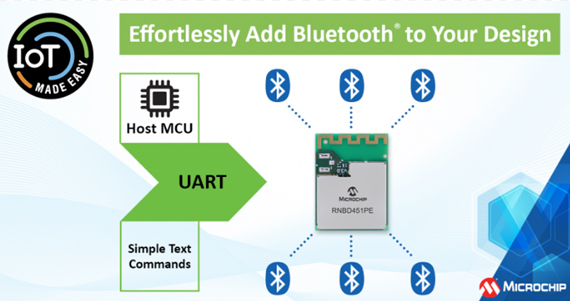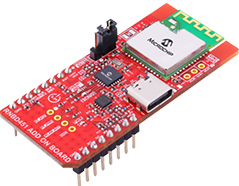
Adding wireless has never been easier
The market for wireless connectivity has witnessed substantial growth and is projected to continue its rapid expansion. The market size is anticipated to escalate from USD 71.6 Billion in 2022 to USD 219 Billion by 2030.
A cursory glance reveals that most products nowadays incorporate some form of wireless connectivity. This ranges from smart home devices such as thermostats and televisions to industrial lighting, smart access, and car entry systems. It is becoming increasingly rare to encounter electronic products devoid of wireless features. Wireless connectivity has transitioned from being a mere advantage to a fundamental necessity across consumer, industrial and automotive products.
Over time, wireless technologies have evolved significantly, enhancing our capabilities. However, this evolution has also led to increased complexity in their implementation, thereby raising the entry barrier. Businesses aiming to integrate wireless features into their products encounter considerable challenges. This puts them at a significant disadvantage in comparison to their counterparts with expertise in wireless technology.
Wireless can be Hard
Incorporating wireless functionality into an application presents significant challenges. These can be broadly classified into three categories: Radio Frequency (RF) design, regulatory certifications and software development.
Starting with RF design, this is arguably the most complex aspect of adding wireless capabilities. It demands a profound understanding of electromagnetic theory, making it a daunting task even for experienced RF engineers. The RF design process entails creating a robust circuit design, followed by a Printed Circuit Board (PCB) that is resistant to external interference and maintains strong signal integrity. Even the slightest changes in parasitic capacitance or inductance can severely affect the circuit's performance. Designing a robust RF circuit involves considering numerous physical effects and conducting extensive testing. These tests necessitate specialized tools and environments, which can be both time-consuming and costly.
With RF design, comes regulations. Various standards bodies define regulations for different wireless protocols across different regions. For instance, the Federal Communications Commission (FCC) regulates wireless products in the United States, the UK Conformity Assessed (UKCA) in the United Kingdom, and the Radio Equipment Directive (RED) in Europe. These regulatory bodies have a defined set of steps and tests that a wireless product must adhere to before it can be sold in their respective markets. Depending on the standards body and wireless protocol(s), the regulatory certification process can take anywhere from a few months to almost a year, and it can cost up to USD 20,000.
Finally, there is software development. The creation of software for a wireless protocol necessitates a comprehensive understanding of that protocol. The intricacies of hardware-software interaction are already complex, and this complexity is further amplified by the frequent updates to protocol specifications and features by relevant groups to rectify vulnerabilities and introduce additional features. Furthermore, software development for wireless is not a one-time task. Consider, for instance, a smart home system. It would likely require a blend of protocols such as Bluetooth and Wi-Fi, contingent on the end nodes in your system. In such a situation, software must be developed for these nodes using different protocols, ensuring these protocols play nice together. This significantly escalates the level of difficulty in developing the software for a wireless system.
Wireless can be Easy
The challenges mentioned above pose significant obstacles to entry into the wireless industry and hinder innovation. Imagine a solution that bypasses these issues entirely, offering a wireless addition that requires no RF design on your part. A solution that has already passed regulatory certifications and comes with pre-installed firmware, eliminating the need for wireless software development. This is where the utility of plug-and-play wireless modules becomes evident.
Plug-and-play wireless modules are RF ready. They come with a robust RF design already in place, allowing you to simply integrate it into your PCB without any RF design. Features such as high transmission power, antenna matching circuit, on-board antenna and comprehensive testing are already implemented.
In terms of certifications, these modules have been tested and approved by relevant regulatory bodies in numerous countries including the US, Canada, UK, Europe, China, Taiwan, Japan and Korea. Additionally, a lot of countries not already covered have their regulations based on one of the existing certifications, saving you both time and money and accelerating your time to market.
Furthermore, plug-and-play wireless modules come with pre-installed firmware. Developers simply need to connect these modules via UART to a host MCU or MPU and issue basic ASCII or AT-style commands. The firmware on these modules handles the complex aspects of the protocol, requiring no understanding or implementation on the developer's part. Additionally, these modules are compatible with Linux, ensuring that you can add wireless functionality to your design with minimal effort, regardless of your host system.
Let's examine the simplicity of the plug-and-play method. Consider, for instance, that you wish to add Bluetooth to your application. A plug-and-play Bluetooth module, such as the RNBD451, is all you require to activate comprehensive Bluetooth Low Energy (LE) functionality. The RNBD451 Add-On Board allows you to create prototypes with RNBD451 modules in minutes by plugging it to a computer via a USB Type-C cable. With the immediate availability of advertisement upon startup, Bluetooth becomes accessible as soon as the module is powered on. After plugging in, all that's left is to launch a terminal of your preference, and you're set to prototype.
To switch the RNBD451 into command mode, simply send "$$$". Once in command mode, ASCII commands can be transmitted over UART to access the desired features, such as scanning for Bluetooth LE devices or activating power-saving modes when Bluetooth isn't in use. Suppose you want to scan for all nearby Bluetooth LE devices. To do this, simply send the command "F" through your terminal. The RNBD451 will then begin to display all detected Bluetooth LE devices in the vicinity. If needed, you can adjust parameters to alter the default scan interval and scan window. To establish a connection with a device, use the connect command "C", followed by either '0' or '1' for public or private address, and then the MAC address of the desired device. This is how easy it is to connect to a Bluetooth device using RNBD451.
The RNBD451 modules are not only user-friendly but also equipped with advanced features. They have the capability to link with multiple Bluetooth devices due to their multi-link and multi-role support. They also offer a high transmission output power of +12 dBm and Coded PHY support, ensuring an impressively extensive range. The modules also provide a remote command mode, enabling command transmission via a connected Bluetooth device. This essentially creates a standalone mode, eliminating the need for a host to send any commands. Moreover, the RNBD451 module incorporates enhancements specific to Bluetooth 5.x, such as the "Advertising Extension". This feature broadens the scope for configuring advertisement data, making it an ideal choice for various Bluetooth LE beacon applications.

Wireless is for everyone
A plug-and-play approach to wireless solutions can significantly reduce the entry threshold, thereby simplifying the integration of wireless capabilities for all with minimal exertion. A ready-to-use RF solution, globally certified for regulatory compliance, which can be effortlessly managed through a simple AT-style command set over UART, empowers developers who wish to add wireless features but lack the necessary expertise or resources. This approach enhances the accessibility of wireless technologies across diverse protocols, fostering innovation. Developers are now equipped to incorporate Bluetooth, Wi-Fi, or both, without having to navigate through the intricacies of either technology.

Figure 1: RNBD451 Block Diagram
RNBD451 highlights
- Bluetooth LE 5.2 stack
- Global regulatory certified (US, Canada, Europe, UK, China, Taiwan, Korea, and Japan)
- Definable beacon feature to make various beacons, such as iBeacon™ and Eddystone™
- Supports PTA control
- Built-in Microchip transparent profile for UART data streaming
- Over-the-Air (OTA) remote configuration
- UART based Device Firmware Update (DFU)
- Built-in Microchip OTA Profile with Client and Server Role for OTA DFU Execution
- Embedded enhanced security
- Multi-Link and Multi-Role
- 2M PHY and long range (Coded PHY)
- Data length extensions and secure connections
- Bluetooth LE Privacy 1.2 with up to eight resolvable and accept lists
- Integrated 16 MHz POSC
- 8 GPIOs
- 12-bit analog-to-digital converters (ADC) successive approximation register (SAR) module for analog to digital conversion
- Add-on up to 6 16-bit UUID GATT services (public service), 4 128-bit UUID GATT services (private service), and each service includes up to 8 characteristic attributes
- Supports Bluetooth LE advertiser, observer, central and peripheral roles
- Supports Bluetooth LE GATT client and server roles

Figure 2: RNBD451 Module Front

Figure 3: RNBD451 Add-on Board
Conclusion
Adding wireless has never been easier. For more information on our high-reliability wireless solutions and to explore our full product offerings, visit our Microchip Storefront today click here
Download article in PDF





